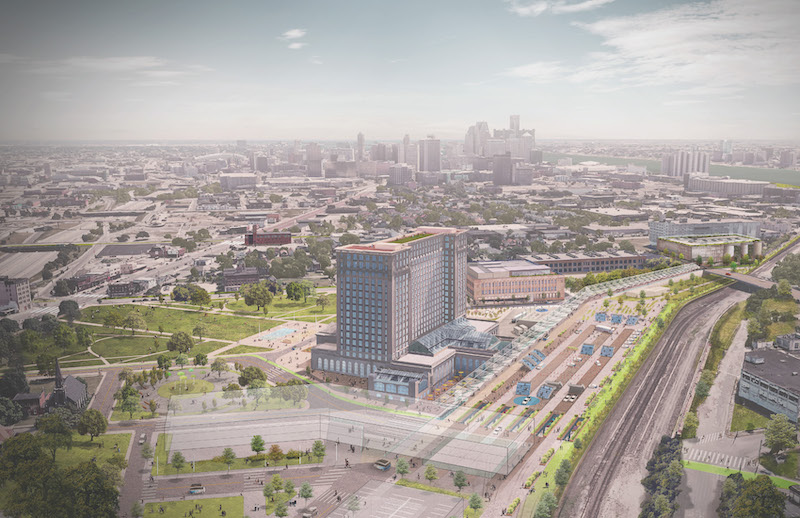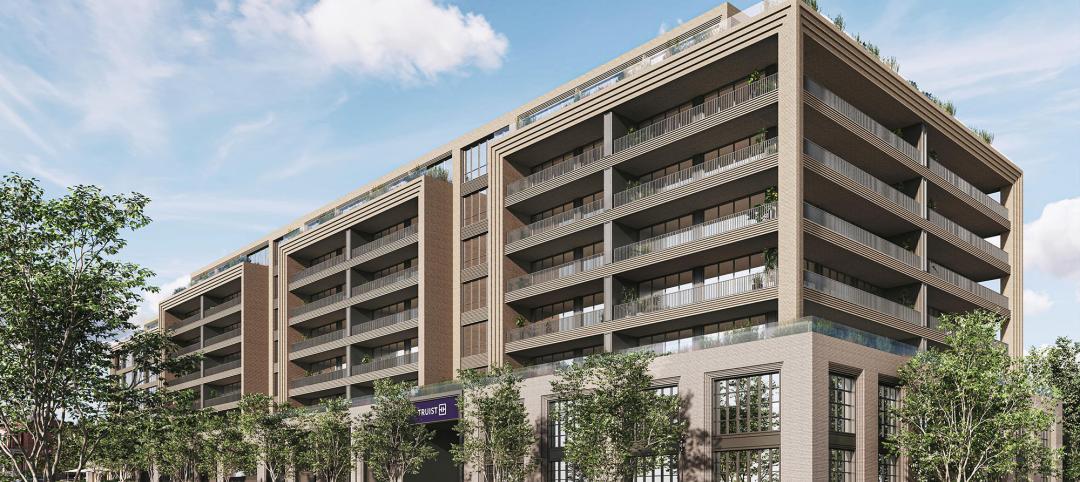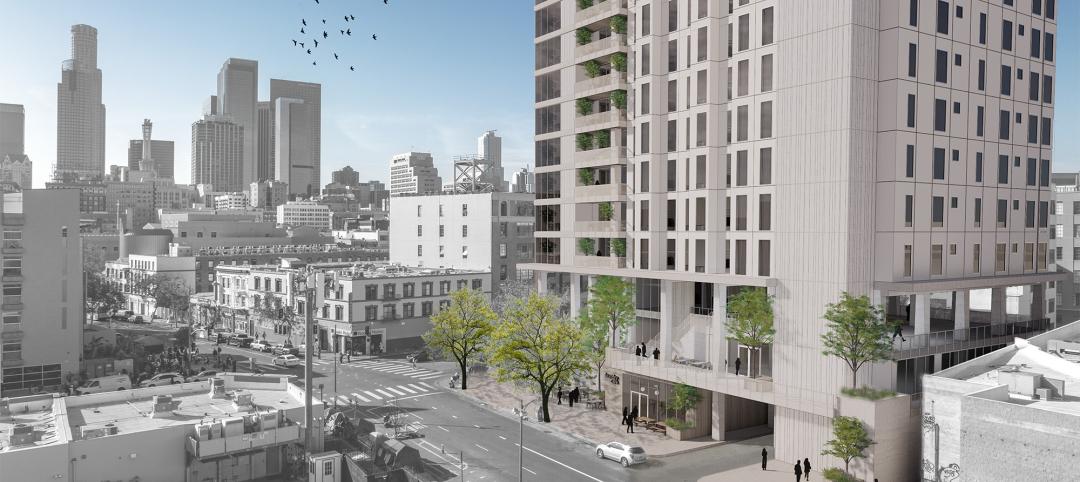Any conversation about what’s wrong with urban America is bound to bring up Detroit at some point. That metro’s July 2013 bankruptcy—the largest municipal filing in U.S. history—culminated decades of mismanagement and corruption that, coupled with rampant crime, caused residents and businesses to flee and tax revenue to plummet, creating a vicious cycle that the once-mighty Motor City, while improving lately, still struggles to reverse.
In Corktown, Detroit’s oldest neighborhood, sits Michigan Central Station, a Beaux-Arts Classical style passenger train depot that opened in 1914. The building, with its grand waiting room and tiled ceiling that soars 230 ft above, represented the city’s glory years. But after it closed in 1988, the station devolved into a pitiable ruin that both manifested and symbolized Detroit’s deterioration. The building’s decay served as the opening images in the third installation of Godfrey Reggio’s The Qatsi Trilogy, a bleak film documentary series that explores how technological and industrial forces had conspired to put human life out of balance.
So it was, perhaps, with a sense of irony that Ford Motor Co., the world’s fourth-largest carmaker, acquired Michigan Central Station in May 2018, and last month unveiled plans to place a reconstructed and repurposed station at the center of a new 30-acre mobility innovation district with 1.2 million sf of commercial space.
Ford has invested $740 million in this redevelopment project, which is part of its executive chairman Bill Ford’s “reimagining of the future of mobility,” says Carolina Pluszczynski, the district’s director of development. “Mobility,” for Ford, encompasses everything from autonomous vehicles to drones and robots, says Pluszczynski. The district will be an open platform that encourages collaboration with other partners. And there has been discussion within Michigan about the district becoming a “node” of a larger “mobility corridor” that would stretch from Detroit to Dearborn to Ann Arbor.
COMMUNITY INPUT GUIDES MOBILITY DISTRICT’S PLANNING
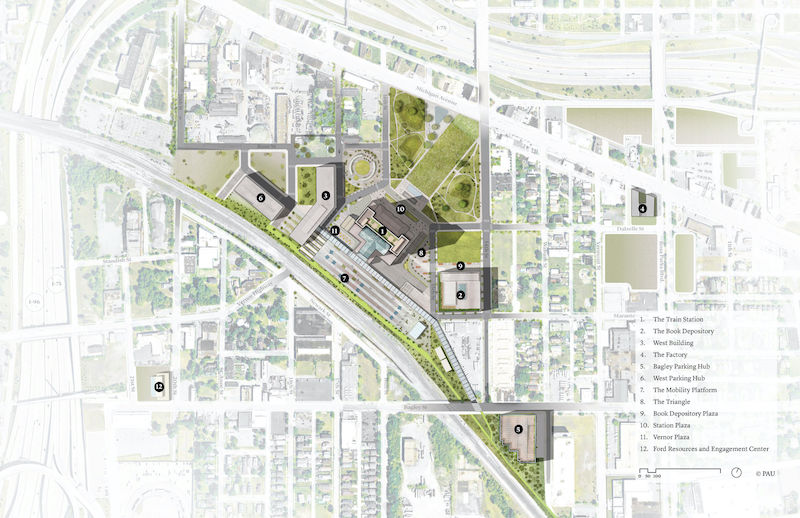
The 30-acre site, located in the Corktown neighborhood in western Detroit, will have four main buildings, including Building West, which is new construction. Parking hubs dot the site's periphery. Image: Practice for Architecture and Urbanism
Practice for Architecture and Urbanism (PAU) is the district project’s lead architect and strategic planner. Mark Faulkner, its Associate Principal, lauds Ford for its attempt at “bringing a piece of history back to life.” The core design themes focus on concentrating density around the station, and wending a walkable area through a unique grouping of buildings and shared spaces that creates a “neighborhood of the future, by everyone, for everyone.”
To develop the site plan, Ford and PAU conducted 18 months of research that was informed by more than 100 hours of discussions with stakeholders and the community.
Michigan Central Station is a massive structure: its 640,000 sf over 18 floors include a basement, the first floor (including the grand waiting room and concourse area) that is being converted for restaurants, retail, and public spaces; a mezzanine floor, two utility floors, 10 floors of a tower that will accommodate office space, and three floors of the tower earmarked for hospitality.
The reconstruction of Michigan Central Station—with Quinn Evans Architects and AvroKO serving as design-architects, and the minority-owned firms Christman and Brinker forming a construction management joint venture—is underway. To scan the building’s interior, Ford hired engineers from Computer Aided Technology Inc., which supplies the carmaker with 3D printing software and hardware.
Also see: A video walk-through of the early stages of Michigan Central Station’s reconstruction
In September, Ford and Christman|Brinker, in collaboration with Detroit at Work, Workforce Development Institute, Barton Malow, SkillSmart, and the Michigan Building and Construction Trades Council, launched “Fast Track,” a jobs program at Michigan Central Station, which provides a pathway from existing training and on-board programs to skilled city workers for future construction. The first 25-person cohort in this program joined 140 construction workers already on-site.
The Central Station’s reconstruction is scheduled for completion by the end of 2022, with the first tenants moving in the first half of 2023. Pluszczynski says that while Ford hasn’t signed any tenants yet, it has activated some programming with local startups. Ford has also partnered with Newlab, which pairs technology experts with industry and civic leaders to empower entrepreneurs. That alliance has already launched two studios—one that addresses macro mobility issues and another that addresses local civic mobility—that eventually will live within the district.
INNOVATION HUB WILL CONNECT THE DISTRICT’S SPACE
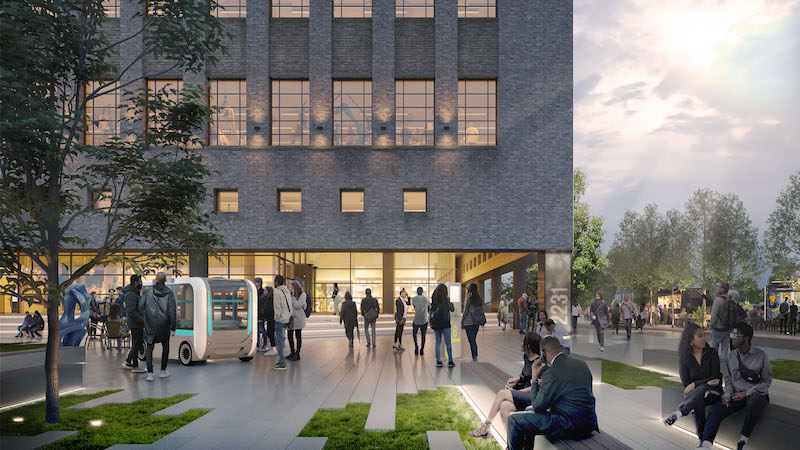
The three-floor Book Depository will become the district's innovation hub. It will reflect the latest thinking in workplace design, and its makeover will include a new roofdeck terrace. Images: Gensler
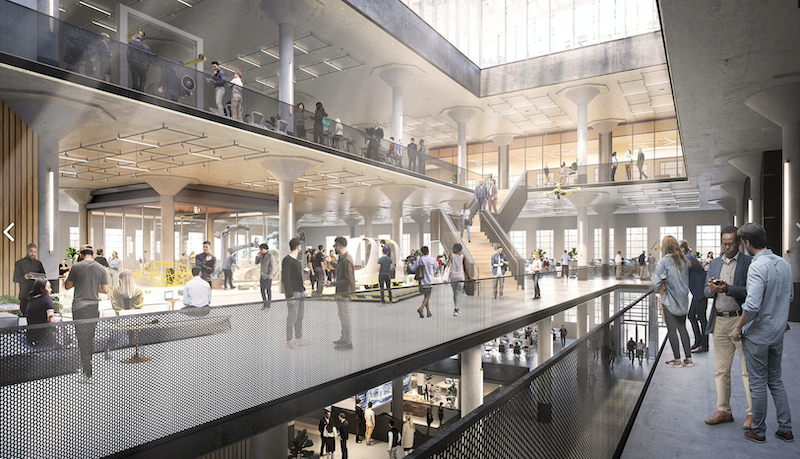
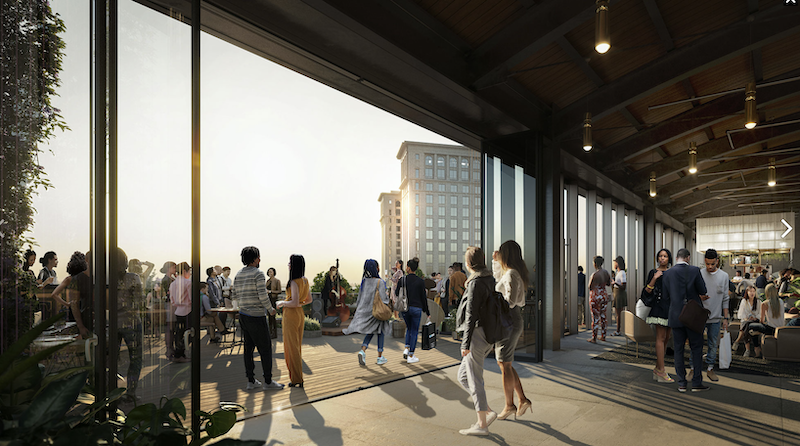
Ford also acquired the former Detroit Public Schools Book Depository, originally designed by Alfred Kahn in the 1930s.This 290,000-sf building will become the district’s primary innovation center for mobility solutions. Its renovated three stories “will reflect how workplace behavior is evolving,” says Lily Diego, Senior Associate and Design Director for Gensler’s Detroit office, which is the design-architect on this building. (Barton Malow is its CM). Diego explains that the space—with its large floorplates, 20-ft-high ceilings, and an offset core—has been redesigned as a kit of parts that can be adjusted for different uses and tenants.
The reconstruction of the Book Depository is scheduled to start in the first quarter of 2021, and be completed by the third quarter of 2022. Diego says the finished product will feature “robust amenities” that include a grab & go market, 24/7 coffee shop, wellness lounge, bike storage and lockers, and a new rooftop terrace.
The Book Depository, she adds, is positioned as a “connecting gateway” to the Michigan Central Station and to a seven-acre, 150-ft-wide mobility platform that, in Ford’s vision, revitalizes elevated railroad tracks behind the station as a walkable outdoor pedestrian and bike path that connects the campus’s buildings with parks, open space, and the surrounding community.
INDOOR AND OUTDOOR PROGRAMMING IN SYNC
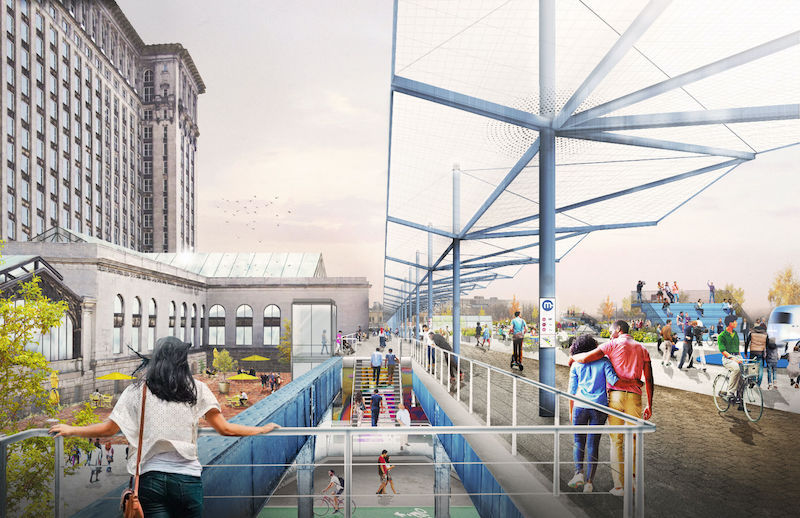
A signature feature of the district will be the revitalization of elevated railroad tracks as a “mobility platform” that's pedestrian-friendly and multipurpose. Image: Practice for Architecture and Urbanism
PAU’s Faulkner—whose firm was involved in the development of New York’s City’s popular High Line—says the Ford district’s mobility platform could have multiple functions that include an event space. He also notes that PAU’s main role on this project “is to make sure the spaces around the building are aligned with what’s going on inside.” To that end, PAU is working with the landscape architecture firm Mikyoung Kim Design.
The district is located next to the underutilized Roosevelt Park that has a street running through it. Faulkner says the site plan calls for that street to be re-routed around the park so as not to disturb the park’s walkability and safety.
Other buildings in the district include The Factory, home to Ford’s autonomous vehicle business unit; and Building West, new construction west of the train station that’s still in the design stage. Pluszczynski says that Ford hasn’t determined yet what Building West will be used for; it could become a training center, she speculates.
The district’s parking needs will be met by hubs located on the site’s periphery. Bagley Parking Hub, with 1,250 slots, has already gone through its design phase (Rossetti is the designer). That hub will enhance street life through exterior artwork, two new public plazas, green spaces, and a tree canopy.
All told, Ford expects 2,500 of its employees will be working within its mobility innovation district by 2022. The district has space to accommodate another 2,500 employees of partners and other businesses.
Other Building Team members on the mobility innovation district project include Jacobs (sustainability), Buro Happold (transportation design), Giffels Webster (CE), Mark Allan & Associates (cost estimating), and Streetsense (market analysis).
Related Stories
Urban Planning | Jan 2, 2024
Federal Highway Administration releases updated traffic control manual
With pedestrian deaths surging nationwide, the Federal Highway Administration released a new edition of the Manual on Uniform Traffic Control Devices for Streets and Highways. The manual contains standards for street markings and design, standardizing signage, and making driving as seamless as possible.
Urban Planning | Dec 18, 2023
The impacts of affordability, remote work, and personal safety on urban life
Data from Gensler's City Pulse Survey shows that although people are satisfied with their city's experience, it may not be enough.
Multifamily Housing | Nov 30, 2023
A lasting housing impact: Gen-Z redefines multifamily living
Nathan Casteel, Design Leader, DLR Group, details what sets an apartment community apart for younger generations.
Condominiums | Nov 6, 2023
Douglas Elliman launches its first Metro D.C. condominium project
Douglas Elliman, one of the largest independent residential real estate brokerages in the United States, announced last week that the firm will be handling the sales and marketing for Ten501 at City Centre West.
Office Buildings | Oct 16, 2023
The impact of office-to-residential conversion on downtown areas
Gensler's Duanne Render looks at the incentives that could bring more office-to-residential conversions to life.
Urban Planning | Oct 12, 2023
Top 10 'future-ready' cities
With rising climate dilemmas, breakthroughs in technology, and aging infrastructure, the needs of our cities cannot be solved with a single silver bullet. This Point2 report compared the country's top cities over a variety of metrics.
Resiliency | Aug 7, 2023
Creative ways cities are seeking to beat urban heat gain
As temperatures in many areas hit record highs this summer, cities around the world are turning to creative solutions to cope with the heat. Here are several creative ways cities are seeking to beat urban heat gain.
Affordable Housing | Jul 27, 2023
Repeatable, supportive housing for the unhoused
KTGY’s R+D concept, The Essential, rethinks supportive housing to support the individual and community with a standardized and easily repeatable design.
Urban Planning | Jul 26, 2023
America’s first 100% electric city shows the potential of government-industry alignment
Ithaca has turned heads with the start of its latest venture: Fully decarbonize and electrify the city by 2030.
Urban Planning | Jul 24, 2023
New York’s new ‘czar of public space’ ramps up pedestrian and bike-friendly projects
Having made considerable strides to make streets more accessible to pedestrians and bikers in recent years, New York City is continuing to build on that momentum. Ya-Ting Liu, the city’s first public realm officer, is shepherding $375 million in funding earmarked for projects intended to make the city more environmentally friendly and boost quality of life.


